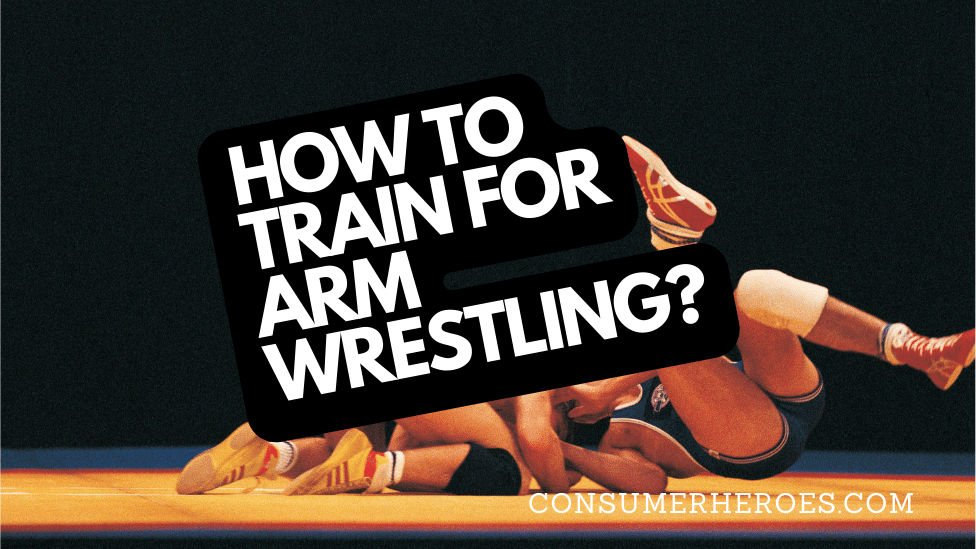Arm wrestling is a sport that requires a unique combination of strength, technique, and endurance. It’s not just about who has the biggest biceps or the most brute force; it’s about using leverage and strategy to outmaneuver your opponent. If you’re interested in getting into arm wrestling or want to improve your skills, training is essential.
To train for arm wrestling, you need to focus on building specific muscles and developing techniques that will give you an advantage on the table. This means working on your grip strength, forearm muscles, and upper body strength, as well as practicing different arm wrestling moves and strategies. With the right training, you can become a formidable opponent and improve your chances of winning matches.
In this article, we’ll explore some of the best ways to train for arm wrestling, including exercises and techniques that will help you build strength and improve your skills. Whether you’re a beginner or an experienced arm wrestler, these tips can help you take your game to the next level and dominate on the table.
Understanding Arm Wrestling
Basics of Arm Wrestling
Arm wrestling is a sport that involves two individuals who try to pin each other’s arm to the table. It is a test of strength, technique, and endurance. Arm wrestling is a popular sport and is played at both amateur and professional levels.
In arm wrestling, the two competitors sit opposite each other with their elbows on a table, and their hands clasped together. The objective of the game is to pin the opponent’s arm to the table by forcing their hand down.
Arm wrestling is not just about brute strength. It also requires technique, speed, and endurance. A good arm wrestler needs to have a strong grip, good wrist strength, and strong biceps and triceps. However, a good arm wrestler also needs to have good form and technique to be successful.
Rules and Regulations
Arm wrestling has some basic rules and regulations that need to be followed. Here are some of the most important ones:
- The competitors must sit opposite each other with their elbows on the table and their hands clasped together.
- The referee will give the command to start the match.
- The competitors must keep their shoulders in line with their arms throughout the match.
- The first person to pin their opponent’s hand to the table wins the match.
- Fouls include lifting the elbow off the table, moving the shoulder out of alignment, and intentionally slipping the grip.
Arm wrestling is a great sport that requires strength, technique, and endurance. Understanding the basics and rules of arm wrestling is essential for anyone who wants to compete in this exciting sport.
Physical Preparation
Arm wrestling requires a combination of strength, endurance, and flexibility. To excel in this sport, it is essential to train all three aspects of physical fitness.
Strength Training
Strength training is crucial for arm wrestling as it helps to build the necessary muscles. The following exercises can help to improve strength:
- Wrist curls: This exercise targets the wrist flexors and extensors, which are important for arm wrestling. To perform this exercise, hold a dumbbell in one hand and rest your forearm on a bench or table. Slowly curl your wrist up and down, keeping your forearm stationary.
- Pull-ups: Pull-ups are a great exercise for building upper body strength, which is essential for arm wrestling. To perform a pull-up, grip a bar with your palms facing away from you and pull yourself up until your chin is above the bar.
- Bicep curls: Bicep curls target the bicep muscles, which are important for arm wrestling. To perform this exercise, hold a dumbbell in each hand and curl your arms up towards your shoulders.
Endurance Training
Endurance training is important for arm wrestling as it helps to improve stamina. The following exercises can help to improve endurance:
- Arm wrestling practice: The best way to improve endurance for arm wrestling is to practice arm wrestling. Start with short matches and gradually increase the duration of the matches as your endurance improves.
- Cardiovascular exercise: Cardiovascular exercise such as running, cycling, or swimming can help to improve endurance for arm wrestling.
Flexibility Training
Flexibility training is important for arm wrestling as it helps to reduce the risk of injury. The following exercises can help to improve flexibility:
- Wrist stretches: Wrist stretches can help to improve flexibility in the wrist, which is important for arm wrestling. To perform a wrist stretch, hold your arm out in front of you with your palm facing down. Use your other hand to gently pull your fingers back towards your forearm.
- Shoulder stretches: Shoulder stretches can help to improve flexibility in the shoulder, which is important for arm wrestling. To perform a shoulder stretch, stand with your feet shoulder-width apart and clasp your hands behind your back. Gently lift your hands away from your body, keeping your arms straight.
Technique Mastery
To become a successful arm wrestler, one must master various techniques. Technique mastery involves developing a strong grip, offensive moves, and defensive strategies.
Grip Techniques
The grip is the most critical aspect of arm wrestling, and it can make or break a match. A good grip technique involves gripping the opponent’s hand in a way that allows maximum leverage and control. The following are some grip techniques that can be used:
- Top-roll grip: This technique involves rolling the wrist over the opponent’s hand, which allows the arm wrestler to use their fingers to apply downward pressure on the opponent’s wrist.
- Hook grip: This technique involves hooking the opponent’s hand with the fingers, which allows the arm wrestler to apply inward pressure on the opponent’s wrist.
- Side pressure grip: This technique involves gripping the opponent’s hand with the thumb and fingers, which allows the arm wrestler to apply sideways pressure on the opponent’s wrist.
Offensive Moves
Offensive moves are used to attack the opponent’s arm and force it down to the table. The following are some offensive moves that can be used:
- Top-roll: This move involves rolling the wrist over the opponent’s hand while applying downward pressure on the opponent’s wrist.
- Hook: This move involves hooking the opponent’s hand with the fingers while applying inward pressure on the opponent’s wrist.
- Press: This move involves applying direct downward pressure on the opponent’s arm, forcing it down to the table.
Defensive Strategies
Defensive strategies are used to prevent the opponent from applying pressure and gaining leverage. The following are some defensive strategies that can be used:
- Posting: This involves placing the elbow on the table and using the body weight to resist the opponent’s pressure.
- Side pressure: This involves applying sideways pressure on the opponent’s wrist, making it difficult for them to gain leverage.
- Top-roll defense: This involves countering the opponent’s top-roll by applying inward pressure on the opponent’s wrist.
In conclusion, mastering these techniques can help arm wrestlers improve their performance and win matches. It is essential to practice these techniques regularly to build strength and endurance in the arm muscles.
Nutrition and Hydration
Proper nutrition and hydration are essential for arm wrestlers to perform at their best. Eating a balanced diet that includes a variety of foods from each food group can provide the necessary nutrients for muscle growth and repair. It is also important to stay hydrated by drinking enough water throughout the day.
Here are some tips for arm wrestlers to optimize their nutrition and hydration:
- Consume enough protein: Protein is necessary for muscle growth and repair. Aim to consume at least 1 gram of protein per pound of body weight each day. Good sources of protein include lean meats, fish, eggs, dairy products, and plant-based sources like beans, nuts, and seeds.
- Eat enough carbohydrates: Carbohydrates provide energy for workouts and competitions. Choose complex carbohydrates like whole grains, fruits, and vegetables, rather than simple carbohydrates like sugar and refined grains.
- Include healthy fats: Healthy fats like those found in avocados, nuts, and olive oil can help reduce inflammation and promote recovery.
- Stay hydrated: Drink enough water throughout the day to stay hydrated. Aim for at least 8-10 cups of water per day, and more if you are sweating heavily during workouts or competitions.
- Consider electrolyte replacement: During intense workouts or competitions, electrolytes like sodium and potassium can be lost through sweat. Consider consuming a sports drink or electrolyte supplement to replace these important nutrients.
By following these nutrition and hydration tips, arm wrestlers can optimize their performance and recovery, and reduce the risk of injury.
Mental Conditioning
Arm wrestling requires more than just physical strength. Mental conditioning is equally important to develop the right mindset to succeed. Here are some tips to help with mental conditioning:
Focus and Concentration
Arm wrestling requires intense focus and concentration. The athlete must remain focused on the opponent’s movements and react quickly to counter them. To improve focus and concentration, the athlete can practice meditation and visualization techniques. Visualization helps the athlete to mentally prepare for the match and imagine different scenarios. Meditation helps the athlete to calm the mind and improve focus.
Dealing with Pressure
Arm wrestling can be a high-pressure sport, especially during tournaments. Athletes must learn to deal with the pressure and perform at their best. To manage pressure, the athlete can practice deep breathing techniques and positive self-talk. Breathing exercises help to reduce anxiety and improve focus. Positive self-talk helps the athlete to stay confident and focused during the match.
In conclusion, mental conditioning is an essential aspect of arm wrestling training. Athletes must develop the right mindset to succeed in this sport. By practicing focus and concentration and managing pressure, athletes can improve their mental toughness and achieve success in arm wrestling.
Recovery and Rest
Rest and recovery are crucial components of any training program, including arm wrestling. Without proper recovery, the body may not have enough time to repair and rebuild muscles, which can lead to fatigue, injury, and decreased performance. Here are some tips on how to optimize recovery and rest during arm wrestling training:
Sleep
Getting enough sleep is essential for recovery and overall health. During sleep, the body repairs and regenerates tissues, including muscles. Aim for 7-9 hours of sleep per night, and try to maintain a consistent sleep schedule.
Nutrition
Proper nutrition is also crucial for recovery. Make sure to eat a balanced diet rich in protein, carbohydrates, and healthy fats. Protein is particularly important for muscle recovery and growth. Consider incorporating foods such as lean meats, fish, eggs, and beans into your diet.
Active Recovery
Active recovery involves low-intensity exercise or movement that helps promote blood flow and reduce muscle soreness. Examples of active recovery include light jogging, swimming, or yoga. Incorporating active recovery into your training program can help speed up recovery and reduce the risk of injury.
Rest Days
Rest days are just as important as training days. Taking regular rest days allows the body to recover and rebuild muscles. Consider taking at least one or two rest days per week, and avoid training the same muscle groups on consecutive days.
Stretching
Stretching is another important component of recovery. Stretching helps improve flexibility, reduce muscle soreness, and prevent injury. Incorporate stretching into your training program, and consider using a foam roller or massage ball to target specific muscle groups.
By incorporating these tips into your arm wrestling training program, you can optimize recovery and rest, reduce the risk of injury, and improve overall performance.
Final Tips
To summarize, training for arm wrestling requires a combination of strength, endurance, and technique. Here are some final tips to help you improve your arm wrestling skills:
- Vary your training: Incorporate different exercises and techniques into your training routine to avoid plateaus and to challenge your muscles in new ways.
- Focus on grip strength: A strong grip is essential for arm wrestling. Utilize grip training tools such as grip trainers, wrist rollers, and hand grippers to improve your grip strength.
- Practice technique: Arm wrestling is not just about brute strength. Technique is equally important. Practice your technique regularly and seek feedback from experienced arm wrestlers.
- Rest and recover: Allow your muscles time to rest and recover between training sessions. Overtraining can lead to injury and hinder progress.
- Stay hydrated and fuel your body: Proper hydration and nutrition are essential for optimal performance. Drink plenty of water and consume a balanced diet rich in protein, carbohydrates, and healthy fats.
By following these tips, you can improve your arm wrestling skills and become a formidable opponent at the table.







